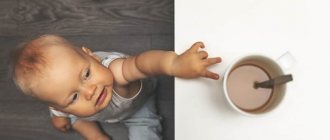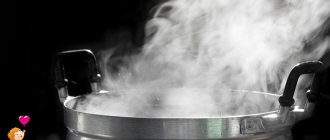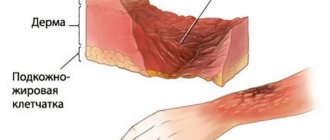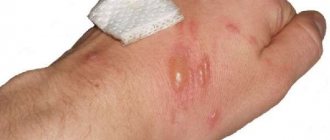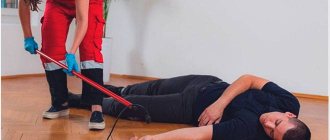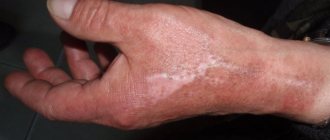Carelessness and carelessness are the main enemies of humanity. In everyday life, the unpleasant consequences of such frivolity are various injuries. Iron burns are common. Adults get it because they are in a hurry, children because of curiosity and parents' loss of vigilance. Such lesions are dangerous and painful. The hands are most often affected. To speed up healing, you need to act quickly, but correctly. This is the only way to ensure successful treatment and avoid complications that threaten the appearance of scars or scars.
Degrees of burns
The first step is to clarify what type of injury you are dealing with.
The causes of iron burns are skin contact directly with a hot surface - the “sole”, as well as hot steam. Iron burns are classified as thermal burns, i.e. skin damage resulting from exposure to high temperatures. They come in 4 degrees of severity:
- First degree burns are characterized by slight redness of the skin, accompanied by burning and peeling of the skin.
- Second-degree burns are accompanied by the formation of blisters filled with a yellowish liquid (exudate). The skin is red and irritated, pain is moderate to severe.
- Third degree burns are serious skin lesions to the full depth, followed by the death of skin particles (outwardly this manifests itself in the form of brown scabs that form at the site of injury).
- Fourth degree burns are the most serious, affecting the muscles and bones. It is almost impossible to get such an injury in a domestic environment.
In addition to identifying the extent of damage, it is important to determine the area of the burn. Doing this yourself is very simple: use your hand as a “measuring device”.
It is believed that the area of skin on the palm is about 1% of the area of the entire skin of the body. Using an iron, carefully measure the area of the burn damage without placing your palm on the damaged area. As a rule, such an injury does not affect more than 1-2% of the skin area.
Why do you need to know this? In case of thermal damage to the skin, it is important to provide first aid as quickly as possible. At home, this can be done only if there is a 1-2 degree burn and no more than 10% of the body is burned, or a 2nd degree burn with no more than 1% of the body area affected. In all other situations, as well as if the victim experiences severe pain, consult a doctor immediately.
Possible consequences
Thermal injuries from an iron are fraught with serious complications. The most common problems can be skin defects - scars or cicatrices that do not heal for several years. Infection is a complication caused by self-puncture of blisters. The affected area, deprived of natural insulation, may fester and therefore require prolonged treatment. In this case, the risk of scar formation increases.
Burns from a hot iron usually cover a small area but can be very deep. Therefore, pain shock cannot be ruled out, especially in a small child. Even a small area of damage sometimes causes loss of consciousness. This condition requires immediate medical attention.
First aid for iron burns
Timely first aid will help speed up further recovery and prevent possible complications. First aid for an iron burn includes the following measures:
- Stopping the traumatic impact – i.e. the victim should be as far away from the iron as possible.
- Cooling the damaged surface - it is best to “substitute” the affected part of the body under a stream of cool water for 15-20 minutes. These actions will reduce pain and limit the area of damage.
- If no blisters appear at the site of the iron burn, then it can be treated with panthenol or another “lifesaver”.
- Next, you need to apply a damp bandage directly to the burn site - a bandage or gauze is suitable for this purpose.
- A victim of an iron burn may experience pain shock: he needs rest, plenty of fluids, and painkillers.
- Further actions depend on the degree of the burn: if blisters appear, it is not recommended to open them to prevent infection. If you suspect that your injury is serious—a third-degree burn or higher—no first aid other than applying a sterile bandage is prohibited. You should immediately contact a medical facility.
How to anoint iron burns?
First of all, remember that you should not smear damaged skin with “whatever comes to hand”: doctors do NOT recommend applying vegetable oils, fats (sour cream, cream, kefir) and other oily substances to the damaged surface. They will only reduce heat transfer and increase the local temperature, which will significantly complicate healing. A place burned by an iron is already not cooling well, and you will make the situation even worse.
If you have been diagnosed with a first or second degree burn, then the damaged area should be wiped with alcohol or a solution of potassium permanganate to disinfect.
To speed up the healing process of iron burns, water-based antibacterial and wound-healing ointments are used.
Unfortunately, iron burns take a long time to heal: dark spots form at the site of damage, and scars may remain. The healing process of a burn is as follows:
- A period of inflammation, which is accompanied by biological processes aimed at eliminating it.
- The renewal period is when the wound cavity begins to fill with new tissue.
- A scar is formed and the wound is covered with new skin.
In order for healing to occur quickly and without complications, an iron burn must be treated. Treatment should be aimed at preventing infection, pain relief, and eliminating infection from the wound. The means used should help improve blood circulation in the damaged area for its speedy healing.
In addition, the skin at the site of an iron burn is highly sensitive and can be dry and irritated. Care for her needs to be effective and at the same time delicate. This is why it is so important to choose the right product.
La-Cri restorative cream is perfect for these purposes. The combination of natural ingredients in the cream allows you to effectively solve various skin problems in a short time. Seed extract copes well with inflammation and itching, violet extract and bisabolol have a calming effect, avocado oil promotes rapid skin regeneration. Apply the cream several times a day until the burn is completely healed - and you will notice how quickly it comes.
When to call a doctor
Even household use of hot oil can lead to disastrous consequences. Doctor's help is necessary in the following cases:
- A child was injured. Children's skin regenerates faster, however, the pain experienced by a baby, especially one who cannot talk about it, is terrible. Panic and chaotic actions will not add any benefit.
- Mucous membranes are affected. Eyes, mouth, throat, genitals.
- The burn area is larger than the victim's palm.
- Pregnancy. The leading physician must assess the potential danger to the mother and fetus.
- The advanced age of the victim.
Timely first aid and the participation of a specialist are the key to successful healing of a burn from boiling oil.
First aid kits with the required medications must be available at production facilities. Timely replenishment is the responsibility of the manager. This article is for informational purposes only, please consult your doctor for details!
Folk remedies
In the arsenal of traditional medicine there are many “grandmother’s” recipes regarding the treatment of burns with an iron. Some of them are not recognized by modern medicine: for example, as mentioned earlier, a burn should not be smeared with sour cream (some do it the “old fashioned way”). The same applies to urine lotions (toxins contained in urine can lead to inflammation, so it is better to refrain from this method).
If you are going to turn to folk remedies, use neutral and safe tips:
- You can apply aloe pulp to the burn site (the leaf is peeled and finely ground). This plant is non-toxic, has good penetrating properties and helps reduce pain.
- You can wash damaged skin with a decoction of linden blossom (the plant is brewed in water in a ratio of 1:10).
- You can apply a cold cabbage leaf to the damaged area - it will cool the skin and reduce inflammation.
- A healing decoction of St. John's wort, calendula, chamomile, nettle and yarrow helps well: 1 teaspoon of each plant is brewed in 2 cups of boiling water, left for 10 hours and the burn is washed with the solution.
- You can apply a compress - a bandage dipped in a soda solution - to the damaged area. Its alkaline composition neutralizes the acidic environment formed on the surface of thermally exposed skin, which means it reduces the risk of burn inflammation.
- It is believed that toothpaste with menthol can reduce the pain from a burn: apply a thin layer to the damaged skin and hold for a while.
Child's burn
Children, no less often than adults, receive household injuries, including iron burns. As soon as the parent is distracted for a second, the curious kid is already climbing to check “where this steam is coming from.” As a result, the child may be injured, not only by a burn from the iron on his hand, but also on other parts of the body.
The situation is complicated by the fact that a child’s skin is even more delicate and thin than that of an adult, which means that even the slightest damage can take much longer to heal.
If you have any suspicions that your baby has been seriously injured, be sure to consult a doctor and stock up on La Cree cream, which is perfect for children’s sensitive skin. Unlike many similar skin treatment products, all La-Cri products have a non-hormonal composition with natural ingredients. Therefore, they can be used even for infants.
And, of course, remember that the best protection is prevention. When working with the iron, follow safety precautions, do not leave the device turned on unattended, and place it out of the reach of children.
Causes of iron stains
They arise from improper handling of an electrical appliance. The iron, which is turned on for a long time, overheats and leaves stains when it comes into contact with the fabric. Modern devices are equipped with a regulator, so when ironing you should take into account the type of fabric and set the desired temperature. The power of the device also matters. If it is small, then the iron heats up slowly. When power consumption is high, this happens in a matter of minutes.
Burnt stains most often appear on fabrics that contain synthetic fibers. They often remain on items made of wool and silk. Cotton and linen are ironed at high iron temperatures and therefore rarely develop brown marks.
Every housewife should remember:
- clothes should be ironed from the wrong side;
- It is advisable to place gauze or a special pad on the fabric;
- It is necessary to monitor the serviceability of the iron and the cleanliness of its soles.
To avoid problems, you can use steamers, but this device also requires careful handling, attentiveness and responsibility.
Expert opinion
The conducted clinical study proves the high efficiency, safety and tolerability of products for daily skin care of children with mild and moderate forms of atopic dermatitis and during remission, accompanied by a decrease in the quality of life of patients. As a result of therapy, a decrease in the activity of the inflammatory process, a decrease in dryness, itching and flaking was noted.
The properties of the cream for sensitive skin are confirmed by clinical research. This tool:
- reduces itching and irritation;
- relieves skin redness;
- moisturizes and gently cares for the skin.
Sources:
- Fundamentals of health development in children. Textbook. — Moscow: Mir, 2016. — 384 p. Tulchinskaya, V.D. Nursing assistance to children / V.D. Tulchinskaya. - Moscow: Russian State University for the Humanities, 2016. - 368 p.
- Andropova T.V., Gudina M.V., Odintsova I.N., Hygiene of children and adolescents, publishing house: Siberian State Medical University Publishing House, 2022 - 101 p.
- Kovyazina N.A., Fedosimova N.A., Illek Ya. Yu. Diagnosis of atopic dermatitis in young children, Vyatka Medical Bulletin, 2007
- Smirnova G.I. Managing the course of the disease: atopic dermatitis in children, Russian pediatric journal, 2014


